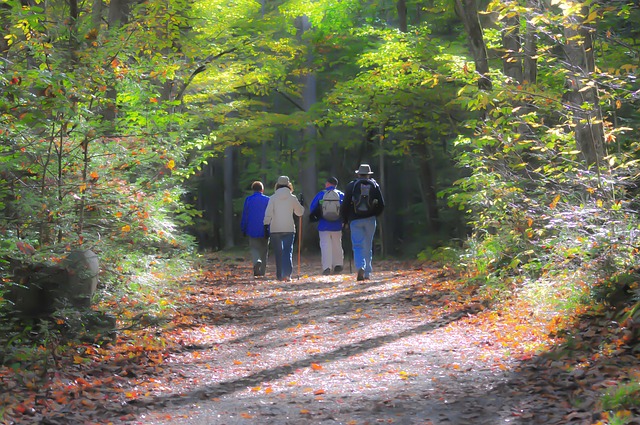Hey there, adventure-seekers! Are you ready to lace up your hiking boots and hit the trail? There’s nothing quite like embarking on a short hike to rejuvenate your spirit and reconnect with nature. But before you take that first step, it’s crucial to be well-prepared. That’s why I’ve put together this guide to help with what to bring on a short hike for a fun and safe adventure. So, grab a cup of your favorite trail mix, sit back, and let’s dive into the article!
Choosing the Right Backpack
Alright, let’s start with the most essential gear for your short hike: the backpack. Think of it as your trusty companion that carries all your belongings and keeps them organized throughout the journey. Here’s what you need to consider when choosing the perfect backpack:
- Comfort and Fit: Look for a backpack that feels comfortable on your shoulders and back. Opt for padded straps and a supportive frame that distributes the weight evenly. Don’t forget to try it on and adjust the straps to ensure a snug fit.
- Size and Capacity: For a short hike, you don’t need a massive backpack. Aim for a size that can hold all your essentials without being bulky. A 20-30 liter backpack is usually sufficient for a day hike, but adjust the size according to your personal needs.
- Compartments and Pockets: Having multiple compartments and pockets is a game-changer when it comes to staying organized on the trail. Look for a backpack with exterior mesh pockets for easy access to water bottles or snacks, and internal pockets to keep smaller items secure.
- Lightweight and Durable: Remember, you’ll be carrying your backpack for hours, so choose a lightweight option that won’t weigh you down. At the same time, ensure the backpack is made from durable materials that can withstand rugged terrain and occasional encounters with tree branches.
- Additional Features: Consider extra features that can enhance your hiking experience. For example, a hydration bladder compartment or external loops for attaching trekking poles. These features can make your hike more convenient and enjoyable.
Remember, finding the right backpack is crucial for your comfort and convenience on the trail. Take your time, try on different options, and choose the one that feels like it was made for you. Once you’ve found your perfect hiking companion, you’re ready to move on to the next step of preparing for your short hike!
Clothing and Footwear
Now that you have your backpack sorted, it’s time to focus on what you’ll be wearing and what will keep your feet happy during the hike. Choosing the right clothing and footwear is essential for comfort and protection. Here’s what you need to know:
- Dress for the Weather: Check the weather forecast before your hike and dress accordingly. Layering is key to adapting to changing temperatures. Start with a moisture-wicking base layer to keep sweat away from your skin. Add a lightweight and breathable middle layer, such as a long-sleeved shirt or fleece, for insulation. Finally, top it off with a waterproof and windproof outer layer to shield you from the elements.
- Comfortable and Flexible Clothing: Opt for lightweight and loose-fitting clothing that allows for easy movement. Choose hiking pants or shorts made of quick-drying and durable materials. Avoid cotton as it retains moisture and can leave you feeling uncomfortable. Don’t forget to pack an extra pair of socks to keep your feet dry and blister-free.
- The Power of Proper Footwear: Your choice of footwear can make or break your hiking experience. Invest in a pair of hiking boots or shoes that provide good ankle support, traction, and protection. Make sure they are broken in before hitting the trail to avoid blisters and discomfort. If you’re going for a less challenging trail, sturdy athletic shoes might suffice.
- Sock Selection: Wearing the right socks is as important as having the right footwear. Opt for moisture-wicking and cushioned hiking socks to keep your feet dry and comfortable. Consider wearing liner socks underneath to reduce friction and prevent blisters.
- Accessories for Protection: Don’t forget to protect yourself from the sun and bugs. Wear a wide-brimmed hat to shield your face and neck from harmful UV rays. Put on a pair of sunglasses to protect your eyes and enhance visibility. Apply a generous amount of sunscreen to exposed skin and bring along insect repellent to keep those pesky bugs at bay.
Remember, comfortable clothing and proper footwear are your allies on the trail. Dress appropriately, take care of your feet, and gear up for an enjoyable hike without any discomfort. With your outfit on point, you’re ready to take the next step toward a memorable adventure!
Essential Navigation Tools:
While getting lost in the beauty of nature can be a delightful experience, it’s always wise to have the right navigation tools to keep you on track during your short hike. Here are the essential navigation tools you should bring along:
- Trail Map and Compass: A reliable trail map is your best friend on the trail. Get hold of a detailed map of the area you’ll be hiking in and study it beforehand. Familiarize yourself with the trail routes, landmarks, and any potential points of interest. Additionally, carry a compass and learn how to use it to orient yourself in case you encounter confusing trail junctions.
- Smartphone Apps and GPS Devices: Take advantage of modern technology by using hiking and mapping apps on your smartphone. There are numerous apps available that provide trail maps, real-time GPS tracking, and helpful information about the terrain. Ensure you have the necessary offline maps downloaded and carry a backup battery or portable charger to keep your phone powered throughout the hike.
- Markers and Trail Signs: Pay close attention to trail markers and signs along the way. They are usually placed at important junctions or points of interest to guide hikers. Look for colored blazes, arrows, or signposts that indicate the correct trail route. If you come across a trail register, take a moment to sign in, as it helps authorities keep track of hikers’ whereabouts.
- Personal GPS Tracker (Optional): For added safety, you may consider carrying a personal GPS tracker. These devices allow you to share your location with family or friends in real-time and can be useful in case of an emergency. Research and choose a reliable GPS tracker that suits your needs and hiking style.
By equipping yourself with the right navigation tools, you can confidently explore the trails and minimize the chances of getting lost. Remember to stay alert, refer to your map and compass, and use technology as a helpful backup. With navigation covered, you’re ready to set out on your short hike with a sense of direction and adventure!
Hydration and Nutrition:
As you embark on your short hike, it’s crucial to fuel your body and stay hydrated to keep your energy levels up and maintain optimal performance. Here are 6 tips to ensure you have the right hydration and nutrition during your adventure:
- Stay Hydrated: Hydration is key, even on a short hike. Carry a reusable water bottle or a hydration bladder and drink water regularly throughout the hike. The general rule of thumb is to drink at least 8 ounces (240 ml) of water every hour but adjust based on the intensity of the hike and weather conditions. Listen to your body and hydrate accordingly. (Here’s how to calculate your perfect hiking water intake.)
- Choose Lightweight Snacks: Pack lightweight and energy-rich snacks to keep you fueled on the trail. Trail mix, energy bars, granola bars, or dried fruit are excellent options. They provide a quick boost of energy and are easy to carry in your backpack. Aim for snacks that are high in carbohydrates and offer a good balance of protein and healthy fats.
- Pack a Nutritious Lunch: If you plan to be out on the trail during mealtime, pack a satisfying and nutritious lunch. Consider sandwiches, wraps, or pre-made salads that won’t spoil easily. Opt for foods that are easy to eat on the go and don’t require refrigeration.
- Don’t Forget Electrolytes: During longer hikes or when hiking in hot weather, replenishing electrolytes is important. Consider packing electrolyte tablets or sports drinks to replace the minerals lost through sweating. These help prevent dehydration and maintain proper muscle function.
- Snack Smartly: Take short breaks along the trail to refuel and rest. Enjoy the beautiful scenery while having your snacks. Listen to your body’s hunger cues and eat when you feel hungry to keep your energy levels steady.
- Leave No Trace: Remember to pack out all your trash and food waste. Preserve the natural beauty of the trail by leaving no trace behind. Dispose of any wrappers or food scraps properly to minimize your impact on the environment.
Take care of your body’s needs, savor the flavors of nature, and keep the adventure going strong!
First Aid Kit and Safety Essentials:
When venturing into the great outdoors, it’s essential to prioritize your safety and be prepared for any unexpected situations. Carrying a well-stocked first aid kit and essential safety items can make a significant difference. Here’s what you should include in your first aid kit and safety essentials:
- Basic First Aid Kit: Pack a compact first aid kit that includes essential supplies such as adhesive bandages, gauze pads, adhesive tape, antiseptic wipes, blister treatments, pain relievers, and any personal medications you may need. Customize the kit according to the length and difficulty of your hike.
- Emergency Contacts: Write down emergency contact numbers, including local authorities and any relevant park or trail hotline numbers. Include the contact information of a trusted person who is aware of your hiking plans. Save these numbers in your phone and carry a printed copy as a backup.
- Safety Whistle: A safety whistle is a simple yet powerful tool for attracting attention in case of an emergency. It can help alert nearby hikers or rescue teams to your location. Attach it to your backpack or keep it easily accessible on your person.
- Flashlight or Headlamp: Always carry a small flashlight or headlamp, even on a daytime hike. It can come in handy if your hike extends into the evening or if you need to navigate through darker areas. Check the batteries before your hike, and consider carrying extras.
- Sunscreen: Protect your skin from harmful UV rays by applying sunscreen before you hit the trail. Choose a broad-spectrum sunscreen with a high SPF, and reapply as needed throughout the day.
- Insect Repellent: Depending on the location and time of year, insects can be pesky. Apply insect repellent to exposed skin or wear protective clothing to deter bugs from bothering you.
Remember, prevention is key to staying safe on the trail. Be mindful of your surroundings, stay on designated paths, and avoid risky behaviors. Should any mishap occur, having a first aid kit and safety essentials at hand will give you peace of mind and the ability to address minor injuries promptly.
Your safety is a top priority, so take a few moments to gather these essentials and ensure they are in your backpack before you embark on your short hike. With proper preparations, you can enjoy your adventure with confidence, knowing that you’re ready to handle any situation that may arise.
Protection Against the Elements:
Mother Nature can be unpredictable, so it’s important to be prepared for various weather conditions during your short hike. Here are 6 essential items to protect yourself from the elements:
- Rain Gear: Pack a lightweight, waterproof jacket or poncho to keep you dry in case of unexpected rain showers. Consider waterproof pants or a rain cover for your backpack as well. Staying dry is not only more comfortable but also helps prevent hypothermia. (Here are layering strategies for wet weather.)
- Sun Protection: Shield yourself from the sun’s rays to avoid sunburn and heat exhaustion. Wear a wide-brimmed hat that protects your face, neck, and ears from direct sunlight. Don’t forget to wear sunglasses to protect your eyes from harmful UV rays.
- Sunscreen: Apply sunscreen generously to exposed skin before heading out on the trail. Choose a broad-spectrum sunscreen with a high SPF rating to protect against both UVA and UVB rays. Reapply sunscreen every couple of hours, especially if you’re sweating or spending extended periods in the sun.
- Insect Repellent: Keep those pesky bugs at bay by applying insect repellent. Use a DEET-based or natural alternative repellent to deter mosquitoes, ticks, and other insects that may be present in the area you’re hiking. Remember to follow the instructions on the repellent label for safe and effective use.
- Extra Layers: Even on a warm day, temperatures can drop as you gain altitude or when the sun sets. Pack an extra layer of clothing, such as a lightweight fleece or a long-sleeved shirt, to keep you warm when needed. Layering allows you to adjust your clothing according to changing weather conditions.
- Hat and Gloves (Depending on the Season): In cooler weather or higher elevations, bring a warm hat and a pair of lightweight gloves to protect your extremities from the cold. These items are especially important if you’re hiking in colder seasons or mountainous regions.
Don’t let rain or intense sun dampen your hiking experience. Embrace the elements with proper protection and enjoy the wonders of nature without worry.
Communication and Essentials:
Staying connected and prepared with essential items can greatly enhance your safety and peace of mind during a short hike. Here are 6 communication tools and must-have essentials to consider:
- Fully Charged Mobile Phone: Before setting off, ensure your mobile phone is fully charged. It’s a valuable tool for emergencies and staying connected with the outside world. Keep it in a secure and easily accessible pocket of your backpack.
- Portable Charger: For longer hikes or when using your phone for navigation, carrying a portable charger is a smart idea. It ensures you have a backup power source to keep your phone charged throughout the hike. Opt for a lightweight and reliable charger with sufficient capacity.
- Emergency Contacts: Save important emergency contacts on your phone and make sure you have easy access to them. Include local authorities, park or trail hotline numbers, as well as the contact information of a trusted person who knows about your hiking plans.
- Notify Someone: Before you head out on your hike, inform a friend or family member about your plans. Share details such as the trail you’ll be hiking, the estimated time of return, and any alternative plans you may have. This way, someone will know to alert authorities if you don’t check in as planned.
- Whistle and Mirror: Carry a whistle with you as a means of signaling for help in case of an emergency. The sound can carry over long distances and attract attention. Additionally, a small mirror can be useful for signaling rescuers if you’re in an open area.
- Trekking Poles: While not essential, trekking poles can provide added stability, reduce strain on your knees, and improve balance on uneven terrain. Consider bringing them along, especially if you have a history of joint issues or if the trial is particularly challenging.
Remember, communication and preparedness are vital for a safe hiking experience. Stay connected, share your plans with others, and carry the necessary essentials. This way, you’ll have the confidence to enjoy your short hike knowing that you’re equipped to handle any situation that may arise.
Optional Extras:
While not necessary, bringing along some optional extras can add enjoyment and convenience to your short hike. Consider the following items to enhance your hiking experience:
- Camera or Smartphone: Capture the breathtaking moments and memories of your hike by bringing a camera or using your smartphone. Take photos of stunning landscapes, wildlife encounters, or simply to document your journey. Just make sure to balance capturing moments with being fully present in the beauty around you.
- Binoculars: If you’re interested in birdwatching or observing wildlife from a distance, binoculars can be a fantastic addition to your hiking gear. They allow you to get a closer look at elusive birds, spot interesting fauna, or admire scenic vistas with greater detail.
- Trekking Poles: As mentioned earlier, trekking poles can provide added stability and reduce strain on your joints, particularly during challenging hikes or when carrying a heavier backpack. They can improve your balance and help navigate steep ascents or descents more comfortably.
- Snacks for Enjoyment: Treat yourself to some extra snacks that bring you joy during the hike. Whether it’s your favorite chocolate, a bag of chips, or a special energy bar, having a tasty treat can be a delightful reward along the way.
- Portable Bluetooth Speaker: If you enjoy listening to music or podcasts while hiking, a portable Bluetooth speaker can add a fun element to your adventure. Choose one that is compact, lightweight, and designed to withstand outdoor conditions.
- Nature Guidebook: If you’re a nature enthusiast or interested in learning about the flora and fauna around you, consider bringing a pocket-sized nature guidebook. It can help you identify different plants, birds, or animal tracks, allowing you to deepen your connection with the environment.
Remember, these extras are optional and depend on your personal preferences and interests. Be mindful of the impact on your backpack’s weight and ensure they don’t distract you from fully experiencing the beauty of nature.
Conclusion:
Now you know what to bring on a short hike and you’re ready to embark on an unforgettable short adventure! Armed with the knowledge from this guide, you’re prepared to tackle the trails with confidence. Remember to pack wisely, stay safe, and immerse yourself in the beauty of nature.
So lace up your boots, take a deep breath, and let the wonders of the outdoors embrace you. Whether it’s a quick escape or a new hobby, enjoy the journey and create lasting memories in the great outdoors. Happy hiking!










